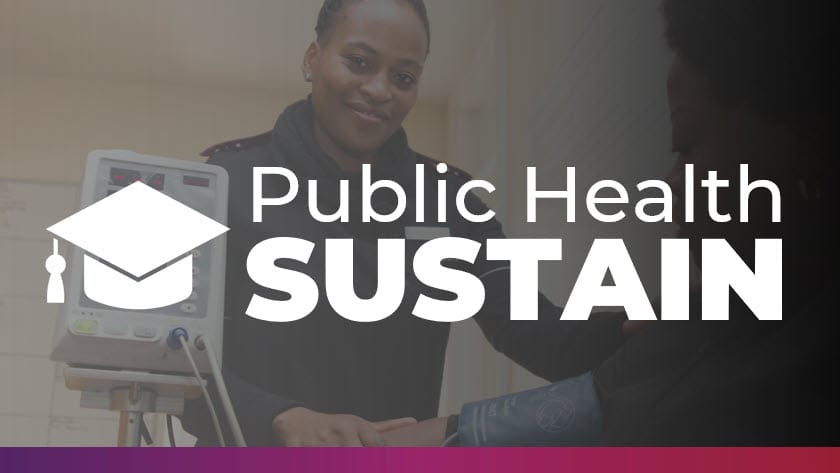Public Health SUSTAIN: Foundational Information about Justice System Involvement for Practitioners
Welcome to Public Health SUSTAIN!
Healthcare workers are critical to the success of people with criminal justice involvement, whether in ensuring people maintain access to needed medication and care while experiencing episodes of incarceration, helping connect people to behavioral health services, or any number of other ways. But the criminal justice system, or, more accurately systems, and the issues people with justice involvement face may be a mystery to healthcare workers. Public Health SUSTAIN (Staff Undertaking Skills to Advance Innovation) is designed to lift the veil covering the criminal justice system and introduce healthcare workers (or anyone interested in learning more!) to what it means to have criminal justice involvement.
In this course, you will explore the complexities of the justice system, learn about the special health and privacy needs of people with justice involvement, and gain tools to help you more effectively work with people who have been impacted by the criminal justice system.
About Course Creators
Heather Toronjo, MA, MPP and Amy Murphy, MPP are Research Associates at the Center for Advancing Correctional Excellence (ACE!) at George Mason University, who work on numerous research studies and translational tools for the justice and health fields. Faye Taxman, Ph.D. is a University Professor and Director of the Center for Advancing Correctional Excellence (ACE!) at George Mason University and serves as Principal Investigator for the JCOIN Coordination and Translation Center. Becki Sutter, DNP is Director of the Mason and Partners Clinics, which serve uninsured and refugee communities in Northern Virginia. The authors are grateful for the support of the National Institute on Drug Abuse and the Public Welfare Foundation.

Public Health SUSTAIN Resources and Further Reading
We hope you have enjoyed learning more about the U.S. criminal justice system through the Public Health SUSTAIN eCourse! Throughout the course, the authors drew upon a number of sources and referred to work being done in at the intersection of justice and health. The following document provides additional information about those resources and links for users to learn more. If you have any questions or problems accessing resources, please contact the course authors.
Lesson One: Introduction to the Criminal Justice System
• Prison Policy Initiative is a non-profit and non-partisan organization that has produced a number of reports illuminating issues around mass incarceration, available from https://www.prisonpolicy.org/reports.html.
Lesson Two: The Social Determinants of Health
• Healthy People, a website from the Office of Disease Prevention and Health Promotion (ODPHP), part of the U.S. Department of Health and Human Services, provides data on the social determinants of health with the objective of helping communities create social and physical environments that will promote better health. These include literature summaries and state and local resources. Visit the website: https://www.healthypeople.gov/2020/topics-objectives/topic/social-determinants-of-health
• The Rural Health Information Hub, a website from the Health Resources and Services Administration (HRSA), part of the U.S. Department of Health and Human Services, describes the challenges that rural residents experience with regard to the social determinants of health. The website includes data on rural health disparities and information on how human services can support rural health. The Social Determinants of Health in Rural Communities Toolkit provides resources to support programs interested in impacting the social determinants of health. Visit the website: https://www.ruralhealthinfo.org
• The American Academy of Physicians provides a number of resources related to the social determinants of health, including Checklist for Clinic Readiness to Implement Social Determinants of Health Screening, a patient questionnaire that addresses social needs, and reports on incorporating the social determinants of health into family practice. The Assessment and Action section provides a guide to screening, a tool to identify resources in the community, and a social needs action plan template. Visit the website: https://www.aafp.org/home.html
• The Accountable Health Communities Health-Related Social Needs Screening Tool from the Centers for Medicare and Medicaid Services, part of the U.S. Department of Health and Human Services, can help providers identify patient needs with housing, food insecurity, transportation, paying utilities, and personal safety. There is also a supplemental tool that addresses financial strain, employment, family/community support, education, physical activity, substance use, mental health, and disabilities. Access the screening tool here: https://innovation.cms.gov/Files/worksheets/ahcm-screeningtool.pdf
Lesson 3: RNR and ASAM
• The GAINS Center of the Substance Abuse and Mental Health Services Agency (SAMHSA), part of the U.S. Department of Health and Human Services, provides a glossary of terms to help understand Risk-Need-Responsivity framework. View the document here: https://www.prainc.com/wp-content/uploads/2018/07/GAINSGlossaryInfographic.pdf
• For more information on the Risk-Need-Responsivity (RNR) framework, you can view George Mason University’s SUSTAIN lesson on Basic RNR, available here: https://www.jcoinctc.org/lessons/risk-need-responsivity-and-asam-criteria/
• In this recorded webinar, Davis D’Amora provides an overview of the Risk-Need-Responsivity (RNR) framework and how to apply it in behavioral health. View the webinar here: https://csgjusticecenter.org/events/risk-need-responsivity-101-a-primer-for-sca-and-jmhcp-grant-recipients/
• The website for the American Society of Addiction Medicine (ASAM) provides extensive information and resources on their website for treatment providers, administrators, and patients. Visit the website here: https://www.asam.org/
Lesson 4: Stigma and Trauma
• View the full video “What is Stigma? We Asked a Top Researcher,” where Dr. Valerie Earnshaw discusses stigma on Addiction Policy Forum’s website. View the video here: https://www.addictionpolicy.org/post/what-is-stigma-we-asked-a-top-stigma-researcher
• The National Employment Law Project provides an overview of “Ban the Box,” a movement to remove questions about criminal history from job applications. This website includes a best practices guide and information on states that have implemented the policy. Visit the website here: https://www.nelp.org/publication/ban-the-box-fair-chance-hiring-state-and-local-guide/
• The U.S. Department of Health and Human Services ended the requirement for an X-waiver, which limited healthcare providers’ ability to prescribe buprenorphine, in 2021. Read about the policy here: https://www.hhs.gov/about/news/2021/01/14/hhs-expands-access-to-treatment-for-opioid-use-disorder.html
• In 2019, JCOIN adopted a person-first language policy that aims to reduce stigma through respectful, accurate, compassionate, and non-pejorative language. View the policy and preferred terminology here: https://www.jcoinctc.org/wp-content/uploads/10252019_JCOIN-First-Person-Language.pdf
• The International Society for Traumatic Stress Studies (ISTSS) aims to disseminate information about the impact of trauma and initiatives that mitigate it. The website includes trauma assessment tools, information on trauma-informed treatment, and other resources. Visit the website at https://istss.org/home
• SAMHSA’s GAINS Center provides information and training on trauma for criminal justice professionals. Visit the website here: https://www.samhsa.gov/gains-center/trauma-training-criminal-justice-professionals
• The National Domestic Violence Hotline offers Tips for Intervening if You Witness Domestic Violence. Visit the website here: https://www.thehotline.org/resources/tips-for-intervening-if-you-witness-domestic-violence/
Lesson 5: Sequential Intercept Model
• Policy Research Associates (PRA) provides extensive information on the Sequential Intercept Model, including research and interventions. Visit the website here: https://www.prainc.com/sim/
• Law Enforcement Assisted Diversion (LEAD), now known as Let Everyone Advance with Dignity in the flagship site, uses police diversion and community resources to improve safety while decreasing the use of incarceration. Visit the LEAD National Support Bureau website here: https://www.leadbureau.org
• The Police Assisted Addiction and Recovery Initiative (PAARI) offers training and resources to help law enforcement agencies implement strategies for deflection and diversion. Visit the website here: https://paariusa.org
• The Crisis Intervention Team (CIT) program, or the “Memphis Model,” dedicates resources to support partnerships with law enforcement, behavioral health professionals, and individuals with substance use and/or mental health disorders. The aim of CITs is to promote non-carceral responses for people with substance use and/or mental health disorders. Visit the website here: https://www.citinternational.org
• Started by a fire chief in New Hampshire, Safe Stations provide a safer option for individuals seeking treatment for substance use disorder. In this model, individuals can seek help at a participating fire or police station with limited threat of becoming justice involved. Learn more in this article: https://www.firerescue1.com/combating-the-opioid-crisis/articles/how-safe-stations-offer-hope-amidst-opioid-epidemic-rCP7fYhMLuCL1cIo/
• The Shelby County Tennessee Jericho Project is a non-specialty court that offers an alternative to incarceration (with restrictions) for people who are post-booking that connects them to services in the community. Learn more here: https://www.prainc.com/wp-content/uploads/2021/03/PracticalAdviceJailDiversion-508-1.pdf
• The Assess, Plan, Identify, and Coordinate (APIC) Model is a best-practice approach for adults with serious mental health disorders who are transitioning from jail into community care. It involves having practitioners “assess client needs and risk to community, plan for immediate and long-term release into the community, identify agencies and programs that can deliver services upon re-entry, and coordinate with those agencies to ensure inmates receive continuous services upon release” (Osher et.al., 2002). Read more here: https://store.samhsa.gov/sites/default/files/d7/priv/sma16-4998.pdf
• SSI/SSDI Outreach, Access, and Recovery (SOAR) is a program model targeting individuals who are returning to the community from incarceration who have experienced homelessness and mental health disorders. A large component of helping individuals transition includes connecting with benefits and helping agencies understand the connections between mental health disorders and incarceration, as well as homelessness. Learn more about SOAR here: https://soarworks.samhsa.gov/sites/soarworks.prainc.com/files/Best_Practices_CJ_Systems.pdf
• Crime Solutions, a web product of the National Institute of Justice, provides overviews of interventions and practices for people with justice involvement and rates them based on the available literature and program evaluations. Browse or search programs and practices here: https://crimesolutions.ojp.gov
Lesson 6: Information Sharing
• The Centers for Medicare and Medicaid Services (CMS) website provides the Covered Entity Decision Tool to help healthcare professionals determine if they and/or their organizations are required to comply with the Health Insurance Portability and Accountability Act (HIPAA). Find out more here: https://www.cms.gov/Regulations-and-Guidance/Administrative-Simplification/HIPAA-ACA/AreYouaCoveredEntity
• Learn more about the history and legacy of Henrietta Lacks and HeLa cells by reading “Honoring Henrietta: The Legacy of Henrietta Lacks.” Visit the website here: https://www.hopkinsmedicine.org/henriettalacks/
• There are special research protections in place for people experiencing incarceration or criminal justice involvement. Learn more about these protections here: https://oprs.usc.edu/irb-review/research-with-prisoners/
Lesson 7: Criminal Justice Interventions
• Learn more about Albert Bandura and social learning theory through some of his writings, including Principled of Behavior Modification (1969) and Social Learning Theory (1977), available from your library or https://bookshop.org/
• The issue brief Risk/Needs Assessment 101 provides more information about the use of risk and need assessment in criminal justice. Access the brief here: https://www.pewtrusts.org/~/media/legacy/uploadedfiles/pcs_assets/2011/pewriskassessmentbriefpdf.pdf
• Many individuals with justice involvement benefit from Cognitive Behavioral Therapy (CBT), and it comes in many different formats and curricula. Learn more about some types of CBT here: https://nicic.gov/cognitive-behavioral-therapy
• Medications for Opioid Use Disorder (MOUD) are an evidence-based practice that help individuals on their recovery paths. View this webinar in the JCOIN Speaker Series to learn more: https://www.jcoinctc.org/medications-for-opioid-use-disorder-in-criminal-justice-settings/
• Integrated behavioral healthcare or primary care behavioral health refers to care in a single setting for physical and behavioral health conditions. It takes a “whole-person care” approach and involves integrated teams in a primary care setting. Learn more here: https://integrationacademy.ahrq.gov/about/integrated-behavioral-health
• Integrated Treatment for Co-Occurring Disorders involves assessing for and treating both serious mental health and substance use disorders in an integrated manner in order to ensure continuity and consistency of services for people with co-occurring substance use and mental health disorders, as well as reduce the burden on the consumers. Learn more here: https://store.samhsa.gov/sites/default/files/d7/priv/ebp-kit-building-your-program-10112019.pdf
• Dialectical behavior therapy (DBT) is a cognitive therapy that is primarily used to treat borderline personality disorder and substance use disorder. It includes strategies that promote acceptance and validation of a person’s capabilities and behavior while promoting behavior change. Learn more here: https://www.ojp.gov/ncjrs/virtual-library/abstracts/correctional-adaptation-dialectical-behaviour-therapy-dbt-federally
• Motivational Interviewing/Motivation enhancement encompasses strategies and approaches that a person can use to promote engagement in treatment individuals who are in different places across the stages of change. These strategies can help to increase engagement in treatment for substance use disorder. Learn more here (also linked in lesson): https://store.samhsa.gov/sites/default/files/d7/priv/tip35_final_508_compliant_-_02252020_0.pdf
Course References:
Addiction Policy Forum. (2020, December 16). What is Stigma? [Video]. YouTube. https://www.addictionpolicy.org/post/what-is-stigma-we-asked-a-top-stigma-researcher
American Academy of Family Physicians. (2021). Assessment and Action. https://www.aafp.org/family-physician/patient-care/the-everyone-project/toolkit/assessment.html
Bailey, Z. D., Krieger, N., Agénor, M., Graves, J., Linos, N., & Bassett, M. T. (2017). Structural Racism and Health Inequities in the USA: Evidence and Interventions. The Lancet, 389 (10077), 1453–1463. https://doi.org/10.1016/S0140-6736(17)30569-X
Ban The Box Campaign. (n.d.). About: The Ban the Box Campaign. http://bantheboxcampaign.org/about/#.YNyb-S1h1AY
Bonta, J., & Andrews, D.A. (2017). The Psychology of Criminal Conduct (6th ed). Routledge Press.
Bronson, J. & Berzofsky, M. (2017). Indicators of Mental Health Problems Reported by Prisoners and Jail Inmates, 2011-12 (NCJ 250612). Bureau of Justice Statistics. https://bjs.ojp.gov/content/pub/pdf/imhprpji1112.pdf
Bronson, J., Stroop, S., Zimmer, S., & Berzofsky, M. (2017). Drug Use, Dependence, and Abuse Among State Prisoners and Jail Inmates, 2007-2009 (NCJ 250546). Bureau of Justice Statistics. https://bjs.ojp.gov/content/pub/pdf/dudaspji0709.pdf
Centers for Disease Control and Prevention. (2021, April 22). Tuskegee Study - Timeline. https://www.cdc.gov/tuskegee/timeline.htm
Center for Substance Abuse Treatment. (2014). Exhibit 1.3-4: DSM-5 Diagnostic Criteria for PTSD. In Trauma-Informed Care in Behavioral Health Services (Treatment Improvement Protocol Series, No. 57). Substance Abuse and Mental Health Services Administration.
Cross, T.L., Bazron, B.J., Dennis, K.W., & Isaacs, M.R. (1989). Towards a Culturally Competent Systems of Care: A Monograph on Effective Services for Minority Children Who Are Severely Emotionally Disturbed (NCJ 124939). Office of Justice Programs. https://www.ojp.gov/ncjrs/virtual-library/abstracts/towards-culturally-competent-system-care-monograph-effective
DeAngelis, T. (2019). The Legacy of Trauma. Monitor on Psychology. https://www.apa.org/monitor/2019/02/legacy-trauma
Dong, K. R., Must, A., Tang, A. M., Stopka, T. J., & Beckwith, C. G. (2018). Food Insecurity, Morbidities, and Substance Use in Adults on Probation in Rhode Island. Journal of Urban Health, 95(4), 564–575. https://doi.org/10.1007/s11524-018-0290-2
Feeding America. (2015). Hunger and Health. https://www.feedingamerica.org/research/hunger-and-health-research
Feucht, T., & Gfroerer, J. (2011). Mental and Substance Use Disorders Among Adult Men on Probation or Parole: Some Success Against a Persistent Challenge (NCJ 235637). Office of Justice Programs. https://www.ojp.gov/ncjrs/virtual-library/abstracts/mental-and-substance-use-disorders-among-adult-men-probation-or
FindLaw. (2019). Drug Possession Overview. https://www.findlaw.com/criminal/criminal-charges/drug-possession-overview.html
Firestone, L. (2012). Recognizing Complex Trauma. Psychology Today. https://www.psychologytoday.com/us/blog/compassion-matters/201207/recognizing-complex-trauma
Gross, T. (2019). The CIA’s Secret Quest for Mind Control: Torture, LSD, and a ‘Poisoner in Chief’. National Public Radio. https://www.npr.org/2019/09/09/758989641/the-cias-secret-quest-for-mind-control-torture-lsd-and-a-poisoner-in-chief
Grusec, J. E. (1994). Social Learning Theory and Developmental Psychology: The Legacies of Robert R. Sears and Albert Bandura. In R. D. Parke, P. A. Ornstein, J. J. Rieser, & C. Zahn-Waxler (Eds.), A Century of Developmental Psychology (pp. 473–497). American Psychological Association. https://doi.org/10.1037/10155-016
International Society for Traumatic Stress Studies. (2021). Healing Trauma Together. https://istss.org/home
International Society for Traumatic Stress Studies. (2021). PTSD Checklist for DSM-5 (PCL-5). https://istss.org/clinical-resources/assessing-trauma/ptsd-checklist-dsm-5
Johns Hopkins Medicine. (n.d.). The Legacy of Henrietta Lacks. https://www.hopkinsmedicine.org/henriettalacks/
Mee-Lee, D., Shulman, G.D., Fishman, M.J., Gastfriend, D.R., Miller, eds. (2013). The ASAM Criteria: Treatment Criteria for Addictive, Substance-Related, and Co-Occurring Conditions. 3rd ed. Carson City, NV: The Change Companies.
Miller, F. G. (2013). The Stateville Penitentiary Malaria Experiments: A Case Study in Retrospective Ethical Assessment. Perspectives in Biology and Medicine, 56(4), 548–567. https://doi.org/10.1353/pbm.2013.0035
National Institute of Justice. (n.d.). Featured Programs and Practices for Road Safety. Department of Justice. https://crimesolutions.ojp.gov
National Institute on Drug Abuse. (2020, June). Criminal Justice DrugFacts. National Institute of Health. https://www.drugabuse.gov/publications/drugfacts/criminal-justice
Office of Disease Prevention and Health Promotion. (2021). Social Determinants of Health. U.S. Department of Health and Human Services. https://www.healthypeople.gov/2020/topics-objectives/topic/social-determinants-of-health
Owens, D.C. (2017). Medical Bondage: Race, Gender, and the origins of American Gynecology. The University of Georgia Press.
Policy Research Associates. (2021). The Sequential Intercept Model. https://www.prainc.com/sim/
Roberts, D. (1997). Killing the Black Body: Race, Reproduction, and the Meaning of Liberty. Vintage Books.
Rural Health Information Hub. (2021). Your First Stop for Rural Health Information. https://www.ruralhealthinfo.org
Sawyer, W., & Wagner, P. (2020). Mass Incarceration: The Whole Pie 2020. Prison Policy Initiative. https://www.prisonpolicy.org/reports/pie2020.html
Steadman, H. J., et al. (2013). Six Steps to Improve Your Drug Court Outcomes for Adults With Co-Occurring Disorders. National Drug Court Institute and SAMHSA’s GAINS Center for Behavioral Health and Justice Transformation. Drug Court Practitioner Fact Sheet, 8(1), 1-28. Alexandria VA: National Drug Court Institute. https://www.ndci.org/wp-content/uploads/C-O-FactSheet.pdf
Steadman, H. J., Osher, F. C., Robbins, P. C., Case, B., & Samuels, S. (2009). Prevalence of Serious Mental Illness Among Jail Inmates. Psychiatric Services, 60(6), 761–765. https://doi.org/10.1176/ps.2009.60.6.761
Substance Abuse and Mental Health Services Administration. (2021). Become a Buprenorphine Waivered Practitioner. U.S. Department of Health and Human Services. https://www.samhsa.gov/medication-assisted-treatment/become-buprenorphine-waivered-practitioner
University of Texas Health Science Center. (2018). You Can Take Action Against Domestic Violence. https://www.uthscsa.edu/sites/default/files/police/2015InterveningtoPreventDomesticViolence.pdf
Wall LL. The medical ethics of Dr J Marion Sims: a fresh look at the historical record. J Med Ethics. 2006;32(6):346-350. doi:10.1136/jme.2005.012559
Washington, H.A. (2006). Medical Apartheid: The Dark History of Medical Experimentation on Black Americans from Colonial Times to the Present. Harlem Moon.
World Health Organization. (2012). Addressing the Social Determinants of Health: The Urban Dimension and the Role of Local Government (ISBN 978 92 890 02691). https://www.euro.who.int/data/assets/pdf_file/0005/166136/UrbanDimensions.pdf





